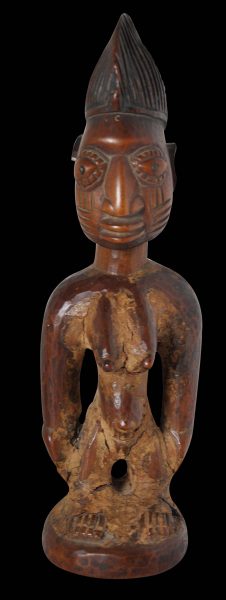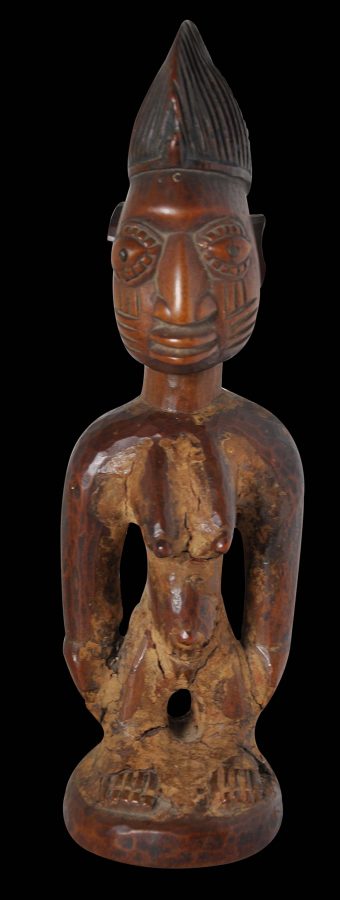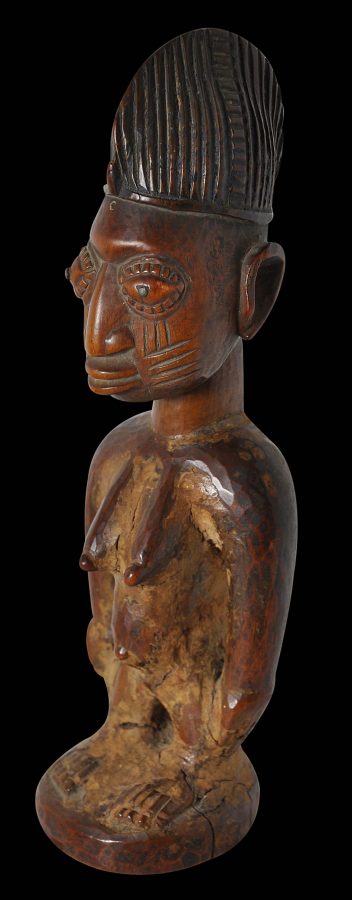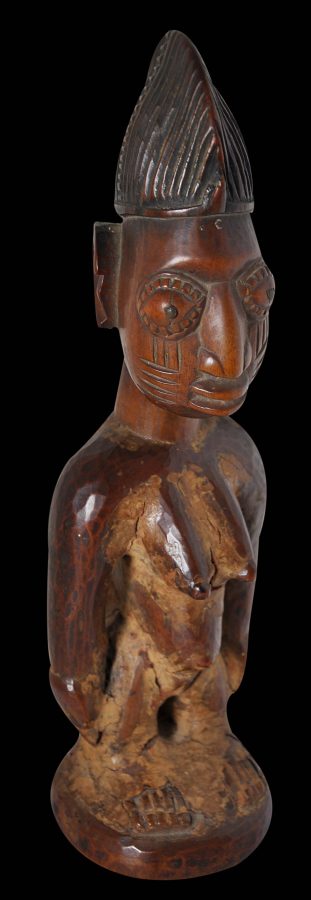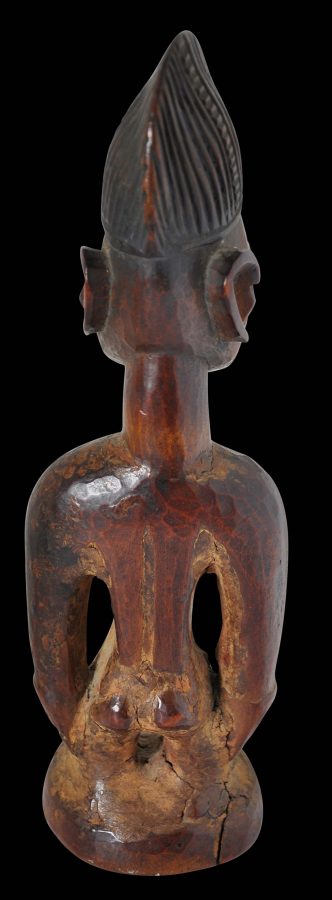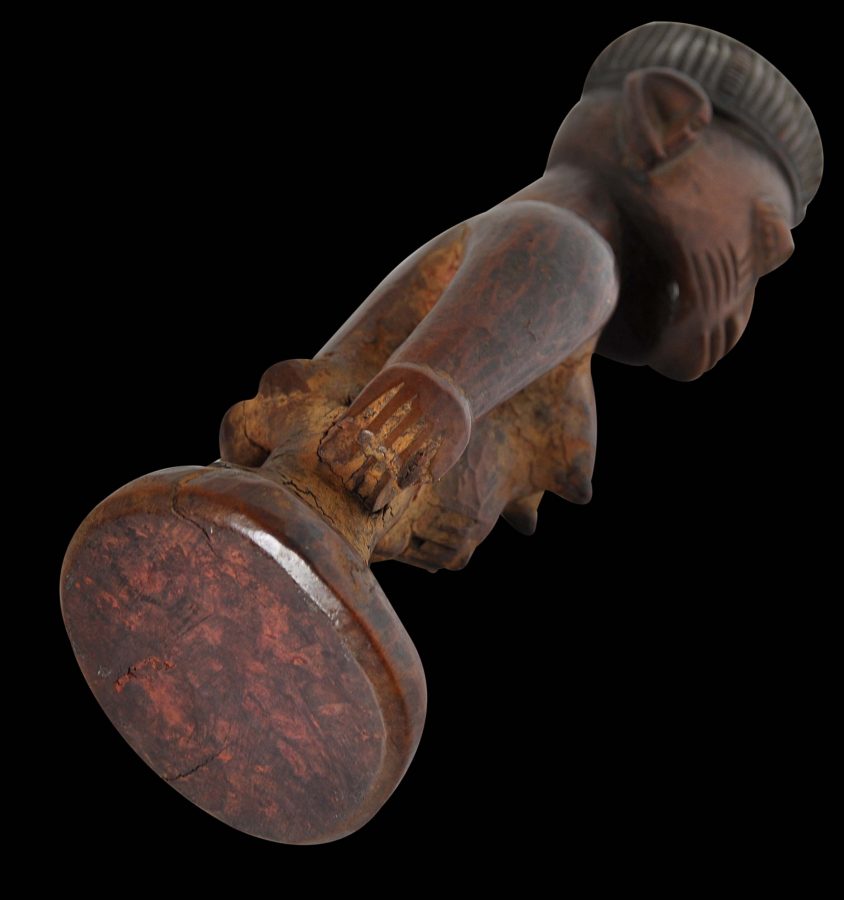Enquiry about object: 2204
Yoruba Ibeji Figure (Ere Ibeji)
Yoruba People, Oyo Sub-group, Erin Region, Nigeria circa 1920
height: 29cm
Provenance
UK art market.
This female Ere Ibeji figure stands with her hands on her hips, and has an appealing and feminine face that is typically Yoruba: bulging almond-shaped eyes, flared nostrils, full lips, and prominent ears. The figure’s eyes are incised with eye lashes (top and bottom), have pierced irises, and exude vigilance with a piercing gaze. Despite the figure’s pretensions of being an infant, it is carved with mature features, such as full pointy breasts, large nipples, a full bottom, strong arms and large feet. (Ere Ibeji is a combination of Yoruba words: ere ‘sacred image’, ibi ‘born’ and eji ‘two’.)
Two sets of seven scarification marks are on the face, under each eye. The over-sized head accords with the Yoruba belief that the head is where the spirit resides. Among the Yoruba, the over-sized head is associated with one’s destiny, and can be a measure of one’s likely success or failure.
Further scarification is evident just above the pubic area, although this is somewhat obscured by tukula wood powder residue.
The coiffure is particularly raised and free of any chips or other damage. A finely plaited hair band runs from above the top of each ear to the crest of the coiffure. A band divides the coiffure from the rest of the head.
Tukula powder has been applied heavily about the body. This powder was grounded from tukula wood and used for both cosmetic purposes and as protection from insects and from the sun. Tukula was also believed to have healing properties and magical powers.
This piece has excellent patina and obvious age. Cracks from the usual age-related shrinkage are minimal. There is a small area of chipping to one ear but this has the same patina as the rest of the image and so is not readily evident. Overall, this is a fine example of a Yoruba ibeji figure.
Yoruba people have the highest dizygotic (non-identical) twinning rate in the world. The births of twins amongst Yoruba women are four times more likely than anywhere else in the world. Unfortunately, the mortality rate of the twins also is very high. Ere Ibeji figures were carved as spiritual representations of the twins who died. These figures were commissioned from village carvers, who were also often highly trained priests (Babalawo). They images were carved as adults, rather than as the deceased infants. It is common in African sculpture that child features in carving are more mature, including elaborate coiffures, scarifications on the face, fully developed breasts (on female figures), pubic hair and prominent genitalia. They were usually placed on a shrine dedicated to
Elegba (a divine messenger deity) in the living area of the house and fed, bathed and dressed regularly. These figures were particularly special to the mother, who kept them close to her and caressed the figures in a loving manner, hence the wear that genuinely old examples exhibit.
References
Bacquart, J. B., The Tribal Arts of Africa, Thames & Hudson, 1998.
Finch, C., Finch & Co, Autumn 2006 – Catalogue No. 9, Finch & Co., 2006.
Fagg, W. and J. Pemberton, J., Yoruba: Sculpture of West Africa, Collins, 1982.
Rowland, A., H.J. Drewal, and J. Pemberton, Yoruba: Art and Aesthetics, Museum Rietberg, Zurich, 1991.


